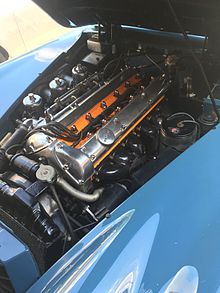The Jaguar XK150 is a sports car produced by Jaguar between 1957 and 1961. It replaced the XK140.
Initially it was only available in fixed head coupé (FHC) and drophead coupé (DHC) versions. The roadster (XK150 OTS – open two-seater) without full weather equipment was launched in 1958. Minimal rear seats were fitted in the coupés. There was no seating or storage space in that part of the open two-seater. The open two-seater broke with tradition and was fitted with high-silled wind-up windows in its new taller doors but retained the very simple folding roof of its predecessors.
Announced in its home market in May 1957 the XK150 bore a family resemblance to the XK120 and XK140 but the XK150 was radically revised. A one-piece windscreen replaced the split screen, and the wing line no longer dropped so deeply at the doors. The widened bonnet opened down to the wings, and on the open two-seater the windscreen frame was moved back 4 inches (102 mm) to make the bonnet longer. The car was available at various times in Red, Pearl Grey, White, Indigo Blue, Claret, Cotswold Blue, Black, Mist Grey, Sherwood Green, Carmen Red, British Racing Green, Cornish Grey, and Imperial Maroon.
The XK140’s walnut dashboard was replaced by one trimmed in leather. On the early drophead coupés, the aluminium centre dash panel, which was discontinued after June 1958, had an X pattern engraving similar to the early 3.8 E-Type. Thinner doors gave more interior space. On the front parking lights, which were located atop the wings (fenders), a little red light reminded the driver the lights were on.
Suspension and chassis were very similar to the XK140, and steering was by rack and pinion; power steering was not offered. The standard engine, the similar to the XK140, but with a new “B” type cylinder head, was the 3.4 litre DOHC Jaguar straight-6 rated at 180 SAE bhp at 5750 rpm

XK150 S 3.4L with Pumpkin Orange cylinder head.
While the first closed and convertible XK150s were slower than their predecessors, the deficit was corrected in the spring of 1958 with the March release — delayed twelve months by the February 1957 factory fire — of special equipment models fitted with disc brakes and an SE engine using twin 1.75-inch (44 mm) SU HD6 carburettors and a modified (B type) cylinder head with larger exhaust valves. Together they boosted the power to 210 SAE bhp at 5500 rpm. Most export cars were SE models. There was a third option for the open two-seater, an “S” engine with three 2-inch (51 mm) SU HD8 carburettors and a straight-port cylinder head. Fitting these options increased power to a claimed 250 SAE bhp.
For 1960 there was the new option of the 3.8 litre engine sold since October 1958 in Jaguar’s Mark IX and rated at 220 hp (164 kW; 223 PS). Tuned for the XK150S its output was 265 hp (198 kW; 269 PS). A 3.8 litre 150S could top 135 mph (217 km/h) and go from 0–60 mph in around 7.0 seconds. Fuel economy was 18mpg. Four-wheel Dunlop 12 in (305 mm) disc brakes appeared for the first time although it was theoretically possible to order a car with drums. When leaving the factory the car originally fitted either 6.00 × 16 inch Dunlop Road Speed tyres as standard, or 185VR16 Pirelli Cinturato CA67 as a radial option on either 16 × 5K½ solid wheels (basic models) or 16 × 5K wire wheels.
Production ended in October 1960 and totaled 2265 roadsters, 4445 fixed head coupés and 2672 drophead coupés. The E-Type replacement was announced in the middle of March 1961.



